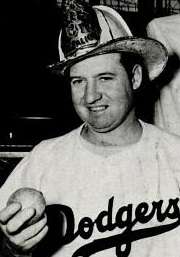Casey was born in Atlanta, GA and originally starting playing professional baseball for the Atlanta Crackers of the Southern Association. He was taken in the Rule 5 Draft by the Chicago Cubs in 1931 and would make his MLB debut for the Cubs in 1935. After three more seasons in the minor leagues, Casey was taken in the Rule 5 Draft again, this time by the Brooklyn Dodgers. The 1939 Dodgers had a 33 year old first year manager by the name of Leo Durocher. Durocher was also the team's starting SS, though it would be the last season he would be a regular player. Durocher found something he liked in this hard thrower, who stood at 6'1 and weighed over 200 pounds, tall and imposing for a pitcher of his time. Though a handful of other Dodgers pitchers were around 6 feet tall, none weighed over 200 pounds.
His first season in Brooklyn he was used mostly as a starting pitcher. Casey would go 15-10, 2.93 in 40 games, 25 as a starter and 15 complete games over 227+ IP. A year later, he appeared in more games as a reliever, pitching in 44 games with just 10 starts. Casey went 11-8, 3.62 and gave up less hits per 9 IP, 7.9, than in the previous season, 9.0. The Dodgers would win the 1941 NL Pennant, one in which Casey had a lot to do with. Durocher would use Casey as a starting pitcher for a stretch during the season because of injuries to pitchers Freddie Fitzsimmons, Curt Davis and Luke Hamlin. By the end of the season, Casey had regained his role as the team's go to reliever and finished with a 14-11, 3.89, 7 saves in 45 games, 18 as a starter. Casey took a loss in game 3 of the World Series to the Yankees, giving up 2 runs in the top of the 8th in a 2-1 loss. Losing two games in the World Series always looks bad for a pitcher, however, Casey was charged with just 2 earned runs in the process. The passed ball by Owen allowed for the 4 runs allowed in game 4 to be all unearned. Prior to 1942, Casey was known to have had a boxing match with celebrated writer Earnest Hemmingway in Cuba- one in which the Dodgers pitcher beat Hemmingway up pretty bad. It took place at Hemmingway's house and because of the fact that many items were broken which, along with Hemmingway's injuries, led to his friendly relations with the Dodgers players to simmer. But it was 1942 where Casey had his breakout season as a reliever, getting 13 saves and finishing at 6-3. 2.25 in 50 games, 2 starts for the Dodgers. After the season, Casey enlisted in the Navy and would not return to the major leagues until the 1946 season- missing 3 full MLB seasons.
It seemed as if the time off did not impact Casey, as 1946 was his best season. He was 11-5, 1.99, 5 saves in 46 games, while making his lone start the final one of his big league career on July 15th. He recorded just one out and gave up 4 hits and 2 runs while taking the loss in a 10-4 defeat to the eventual National League Champion Cardinals. The following season, Casey went 10-4 and led the NL with 18 saves as the Dodgers won the NL Pennant. Of course, that was the season in which Jackie Robinson broke the color barrier and the one in which Durocher was suspended for the entire season for his association with gamblers. Casey was very good in the World Series, going 2-0 with a save while pitching in 6 games and giving up just a run in 10+ innings.
Unfortunately, Casey was not the same in 1948. He pitched to a 8.00 ERA and was released by the Dodgers at the end of September. He joined the Pittsburgh Pirates for the 1948 season and pitched a little better, a 4.66 ERA in 33 games out of the pen. However, a last place team looking to get younger had no place for a 35 year old reliever who was not lights out. He was released on August 10th and signed with the New York Yankees- his rivals in the 1941 and 1947 World Series. He appeared in 4 games in the regular season but did not pitch in the World Series; one which was once again a victory for the Yankees over the Dodgers. Casey finally received his World Series ring as a member of the Yankees.
Casey could not find a MLB team to offer him a contract for the 1950 season. So he returned to his roots, signing to play for the Atlanta Crackers of the Southern Association, where he started his professional career. He went 10-4 as the team won the Pennant. However, Casey did not play professional baseball in 1951. Some players are unable to cope with life without baseball and Casey was one of them. He was going through a divorce and in the process was being accused as the father of a child in a paternity suit. On July 3, 1951, he was in his Atlanta hotel room speaking with his estranged wife when he shot himself in his neck, ending his life at the age of 37. He died in Atlanta, where he was born and where he started and finished his professional baseball career.


 RSS Feed
RSS Feed
